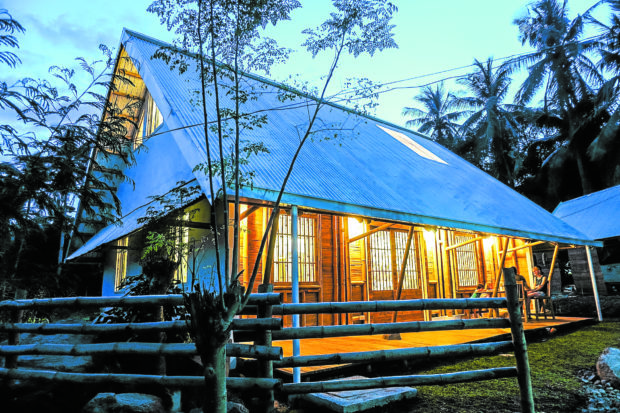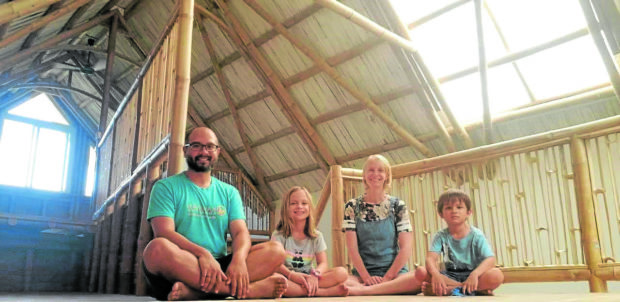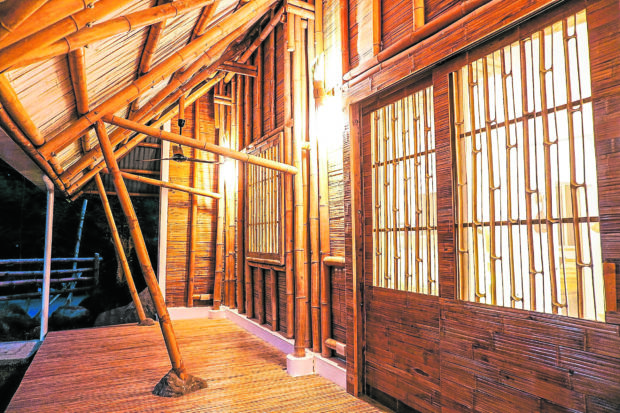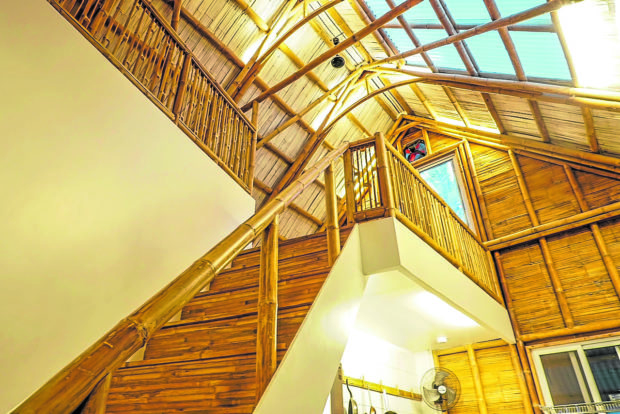Negros house isn’t your typical ‘kubo’

FAMILY AREA At dusk, members of the Villanueva family spend time at the porch of their bamboo and “bato” house in the town of Dauin, Negros Oriental province. Architect Ray Villanueva and his wife Amy chose bamboo as the main material for their dream home due to its versatility. —BENZI FLORENDO/CONTRIBUTOR
DUMAGUETE CITY, Negros Oriental, Philippines — When Typhoon Odette (international name: Rai) barreled through Negros Oriental province on Dec. 16 last year, a house made of bamboo in the town of Dauin survived the onslaught even if it was within the 60-kilometer radius of the eye of the strongest storm that hit the Visayas in 2021.
This didn’t come as a surprise to its owners Ray Villanueva, a United States-trained architect, and his American wife, Amy Ellingson, since several countries in South America have revised their building codes to include bamboo after houses made of this natural material survived earthquakes, faring better than modern buildings made of concrete and hollow blocks.
The “BnB” (referring to housing materials, bamboo and “bato”) that they built in Dauin, 16 km south of here, is a two-bedroom house with a loft and a porch made from bamboo and bato, an old technique that they want to revive.
“The finished BnB is a showcase of the soaring potential for treated bamboo as structural timber—at a price point for middle-income families,” Villanueva said.

SPACE TO RELAX Ray and Amy Villanueva and their children June and Lou relax at their loft
made of lightweight but sturdy bamboo. —AMY ELLINGSON VILLANUEVA/CONTRIBUTOR
Inspiration
The couple has been advocating the use of bamboo—from houses to furniture pieces—after falling in love with the bamboo houses in Mindanao that Villanueva saw when he was young.
Article continues after this advertisementThose structures, reflecting the design of the Philippine “bahay kubo” (traditional hut), became their inspiration when they put up Kawayan Collective in 2018, a business enterprise they set up aimed at maximizing the ubiquitous grass and the skills of local bamboo craftsmen.
Article continues after this advertisementVillanueva finished summa cum laude in architecture at the University of Maryland, and then completed his master’s thesis for the architecture program at the University of Washington in 2007.
He and his wife first came to Dumaguete in 2011 after he received a teaching post at the Foundation University.
Together with Foundation University president Victor Vicente Sinco, another US-trained architect, Villanueva and Ellingson started Estudio Damgo in 2011, a design-build capstone program for senior architecture students, that maximized the use of locally available bamboo.
The couple returned to the United States in June 2013, shortly after the birth of their daughter, June.
Five years later, the couple decided to return to Dumaguete where they planned to raise June and son, Lou.
They also wanted to put up an enterprise that would showcase the Philippine bamboo.
They first settled in Dumaguete until they found a 400-hectare lot in Dauin, where bamboos thrive and there is a rich source of skilled workers.
The couple then put up Kawayan Collective, a bamboo treatment facility in Barangay Maayong Tubig, which also designs and makes bamboo furniture.
Since 2019, the family and their crew of 25 skilled local workers at Kawayan Collective Bamboo Treatment Facility have been producing over 300 construction-grade bamboo poles each week, including bamboo panels and bamboo products like furniture and housewares, to achieve their vision as a zero-waste facility.
When the pandemic hit the country in 2020, they donated bamboo beds to front-liners.

INTERIOR DETAILS The Villanueva family home features smooth bamboo floor on the “bato”-strengthened porch that leads to an intricate bamboo sliding door designed by Kawayan Collective. —AMY ELLINGSON VILLANUEVA/CONTRIBUTOR
Dream come true
Last year, Villanueva decided it was time to build the family’s dream house that would showcase their love for bamboo.
Construction of the 130-square-meter, two-bedroom house started in February 2021, using cement-bamboo frame technology, a process accredited by the National Housing Authority.
Seven months later, the family opened their new home.
At least 80 percent of the house was made of treated bamboo — primary structural support for the roofs and walls as well as the interior finishes and exterior docking.

A bamboo “ladder” leads to the loft while its living room is fitted with bamboo furniture. —AMY ELLINGSON VILLANUEVA/CONTRIBUTOR
Traditional techniques
“The house uses whole poles to frame the walls and to provide roof structure. Important details include an insulated roof and screened windows that allow for good airflow, and minimize the need for air-conditioning or daytime lighting,” Villanueva said.
He said they used a traditional building technique known as “wattle and daub,” locally referred to as “tabique pampango” that was used during the Spanish colonial period.
Villanueva said that in the 1800s, bamboo, timber and plaster (cement mixed with seashells, gravel, clay and other materials) were combined to form the walls for major buildings like the 200-year-old San Isidro Labrador Parish church in Lazi town, Siquijor province.
“Because the bamboo was encased by plaster, it was safe from deterioration from sun and rain,” he said.
In “wet areas,” like the kitchen and bathroom, concrete slabs and hollow blocks were used to prevent deterioration, he added.
But the loft is built entirely from bamboo—from the floor joists to the trusses, as well as the engineered bamboo flooring and furniture, he added.
Natural choice
Ellingson said building the BnB house was their way to diversify during the pandemic.
“We wanted to build a house that would be marketable, and that could also showcase all the products and possibilities for Kawayan Collective,” she said.
Villanueva said they always believed that bamboo was the natural choice for construction since it was abundant, affordable and embedded in the local culture.
“The durable bamboo design is now affordable for middle-income Filipino families as well,” he said.
The BnB, for instance, cost about P3.1 million, or P24,000 per square meter, said Ellingson.
“Our BnB house is especially suited for the tropical environment, built to withstand everything from typhoons to termites, and also built beautifully: open to the breeze and soaring to the sky in celebration of the traditional forms of Philippine architecture,” she said.